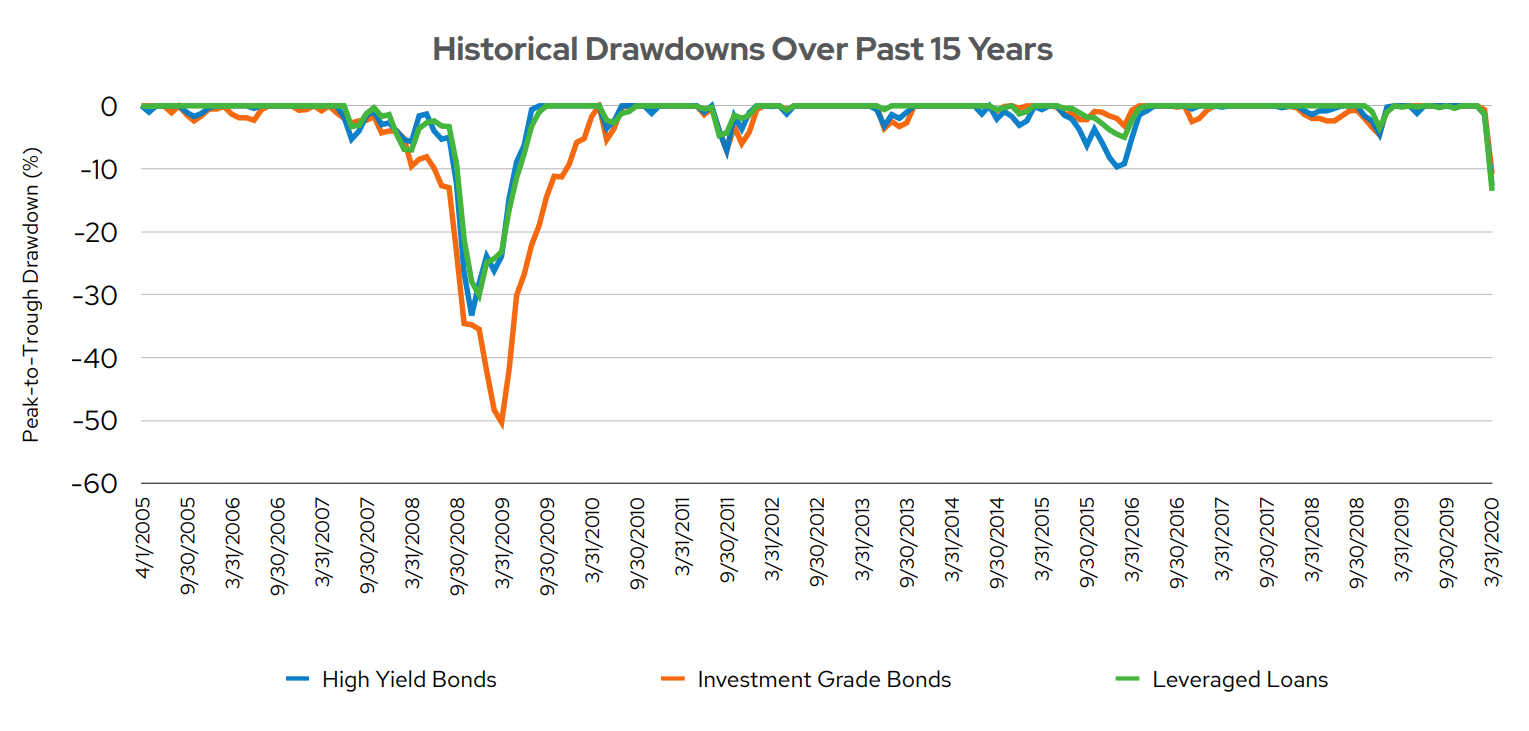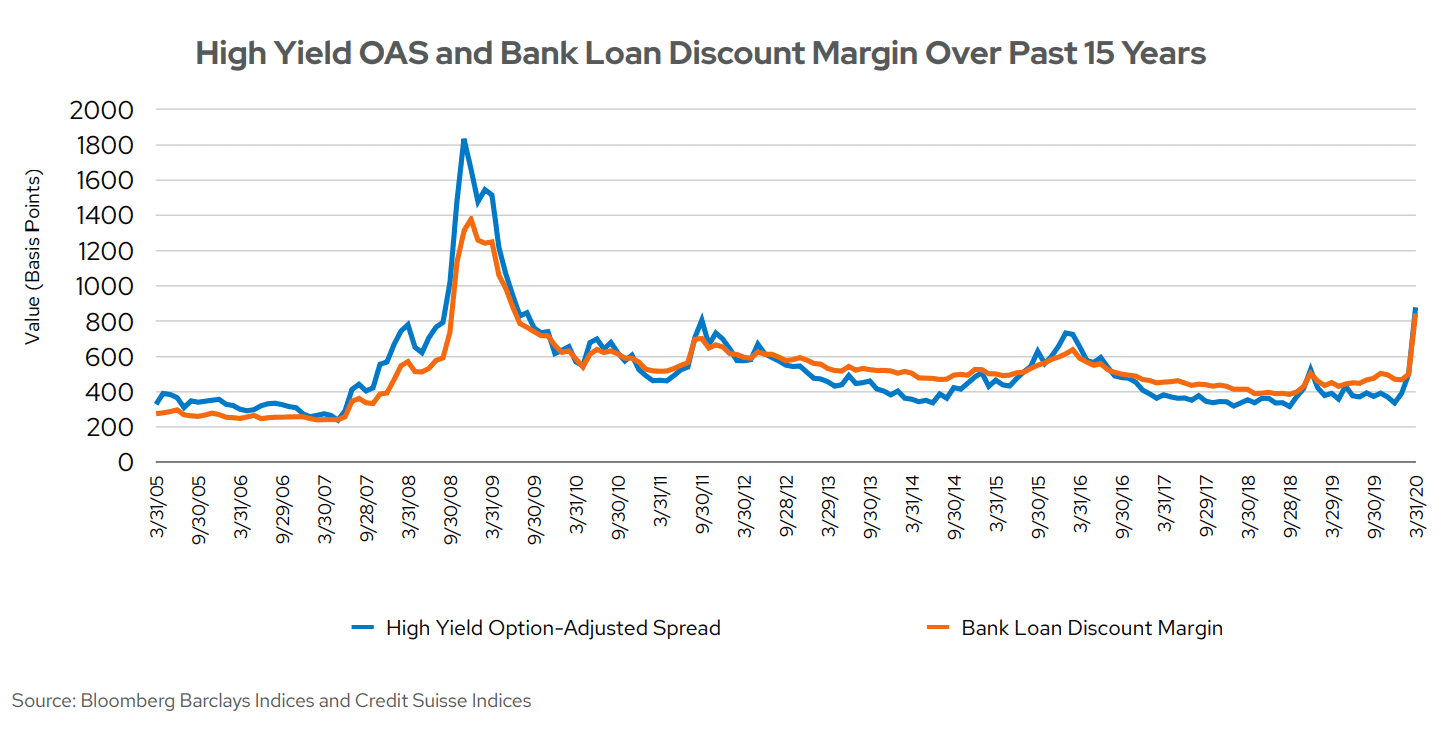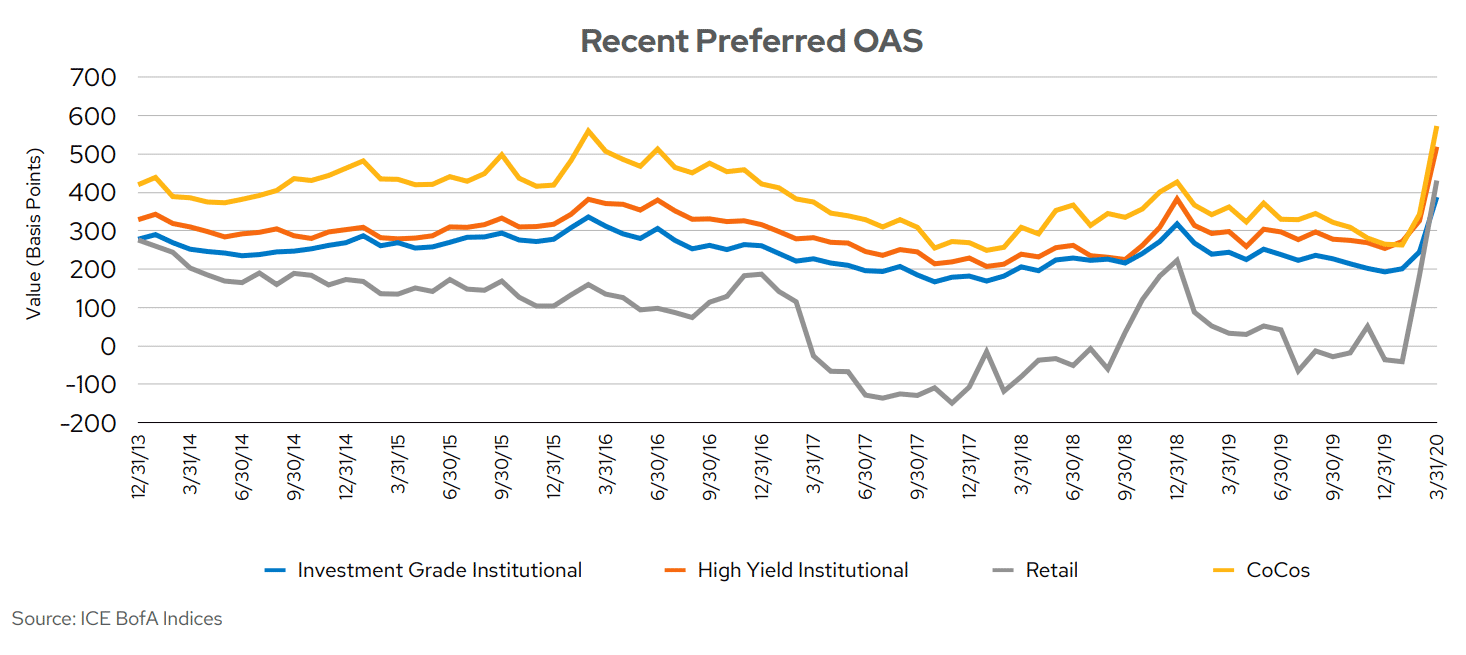Commentaries
Analyst Insight: Credit Catches the Coronavirus
Analyst Insight: Credit Catches the Coronavirus
investpmc.com | pmcsales@investpmc.com
Highlights
- The COVID-19 market downturn has been particularly challenging for bond markets, with spreads widening to their highest levels since the Financial Crisis amid unprecedented redemptions that have strained market liquidity. These effects have been even starker in the leveraged credit markets, proving that attractive yields carry significant risk.
- Unfortunately, many yield-hungry investors, who may have been forced out of their preferred habitats due to historically low interest rates following the Financial Crisis, are learning this the hard way. This is not to say that high yield bonds, bank loans, and preferreds do not have a place in an investor’s diversified asset allocation—they most certainly can.
- However, investors who understand the kind of ride they are getting on are less likely to get off prematurely. Furthermore, PMC contends that in less trafficked, complex, and opaque asset classes like these, active management is a good way to mitigate some of this volatility.
- For those with the capital and the tolerance for risk, history suggests that investing in current spread levels has led to aboveaverage, forward-looking returns. However, the lingering uncertainty around the length and full impact of this pandemic complicates the picture.
Since the novel coronavirus pandemic (COVID-19) became a global crisis in February, schools and businesses have closed, millions have joined the ranks of the unemployed, everyone who is able is working remotely, and trips to the grocery store have become odysseys fraught with peril. Meanwhile, shelter-in-place orders in many states have shuttered vast swaths of the economy and led to significant inconvenience as we all strive to flatten the curve and prevent our hospitals and healthcare workers from being overwhelmed. For income-starved investors with heavy allocations to leveraged credit, this crisis piled more pain on top of all these anxieties, as the securities that had provided relatively attractive yield in the pre-COVID-19 world produced their largest drawdowns since the 2008-2009 Global Financial Crisis.
Before checking their investment accounts, bond investors might reasonably have expected their bond allocations to have produced returns closer to the Bloomberg Barclays US Aggregate Index, which returned 3.2% for the quarter, than the S&P 500 Index, which dropped a precipitous 19.6%. However, prior to this pandemic many found the paltry yields of investment grade bonds insufficient and extended along the risk spectrum into high yield, bank loans, and preferreds—all of which produced returns closer to the S&P in the first quarter of 2020.

Whereas drawdowns in the Financial Crisis occurred more gradually, the suddenness of the drop in these asset classes is clear. In one month, these three indices produced their largest drawdowns since that period. The Bloomberg Barclays US Corporate High Yield Index fell 12.7%, the S&P/LSTA Leveraged Loan Index dropped 13.1%, and the ICE BofA US Investment Grade Institutional Capital Securities Index, which comprises institutional preferreds, lost 9.6%. Spiking correlations and illiquidity only added to investors’ woes as they fled credit and longer-dated securities in favor of Treasurys and cash.
These eye-watering returns came as investors repriced credit risk, approximated by option-adjusted spread (OAS). The roughly equivalent metric for bank loans is discount margin (DM). Both metrics reached post-crisis highs in March.

As these heightened readings imply, the market expects defaults to rise in the coming months. Bonds and loans issued by firms with revenues tied to commodity prices, travel, tourism, and gaming/leisure are likely to become bankruptcy hotspots. Although much of this blowout is fundamental, a portion is due to the illiquidity of these asset classes, both of which present opportunities for active investors. Furthermore, forward-looking returns are typically strong when spreads and discount margins are at such elevated levels.
The preferred stocks of financial institutions have also had their fair share of volatility in recent weeks. With the exception of contingent capital securities (CoCos), these securities are technically stock, but most market participants view them as debt due to their bond-like characteristics. Spreads on these securities have also widened, as concerns about revenues and loan exposures, along with a healthy degree of fear that banks (the most common issuers of preferred stock) might again precipitate a financial crisis, have spooked many investors.

Although drawdowns in environments like these should be expected, Doug Baker, who manages preferred securities portfolios at Nuveen, notes that banks and insurers, which make up more than 80% of the preferred universe, are well capitalized and are regularly stress tested. In fact, all major US banks passed their Federal Reserve stress tests in 2019. They also significantly curtailed their lending to energy firms after the 2014-2016 commodity price downturn, and now hold much less direct loan exposure to these volatile firms. Risk clearly remains in this space, but it also is clear that investors, who at various points over the last few years have actually bought retail preferreds at negative OAS, now have a more attractive entry point.
As the exponentially rising contagion and death tolls suggest, markets may yet plumb deeper depths. The CDC reckons that we are still in the acceleration phase of the pandemic in the US, and that its duration and severity depend on the efficacy of our public health response. Entire sectors of the economy are likely to remain shut down or seriously hampered by physical distancing measures and broad lockdowns, potentially for months. On the extreme end of estimates, the Federal Reserve Bank of St. Louis estimated that unemployment could reach 47 million, driving the unemployment rate to 32%. With initial unemployment claims hitting a record 6.6 million for the week ended March 28, surpassing last week’s record of 3.3 million, many are already experiencing economic hardship, and it certainly will get worse.
Despite, or perhaps more accurately, because of this dire situation, opportunities have been arising in these inefficient markets as investors have rushed to the safety of cash and Treasurys. As current spreads and discount margins attest, for investors with the willingness and ability to add and tolerate the risk, which has just proven itself capable of wrenching guts, valuations now stand at some of their cheapest levels in years. However, not all vehicles are created equal when attempting to exploit these relatively cheap opportunities.
Although index-tracking ETFs can provide cost-effective exposure to thoroughly covered, liquid asset classes, PMC has long held that fixed income is generally more conducive to active management, not least because of its over-the-counter trading, illiquidity, and diversity of security structures. These characteristics are even more pronounced in leveraged credit and complex asset classes like preferreds. Our vetted highconviction active managers are well positioned to avoid the sectors, structures, and trends with the weakest outlook and emphasize those with the most promising attributes and valuation.
Disclosure
All macroeconomic data was obtained from Bloomberg.
Investors should consider the investment objectives, risks, and charges and expenses of mutual funds carefully before investing. A prospectus or summary prospectus which contains this and other information about these funds can be obtained by contacting your Financial Advisor or the fund company directly. Please read the prospectus carefully before investing.
As with all investments, there is no assurance that any investment strategies will achieve their objectives or protect against losses. Index Performance is presented for illustrative purposes only and does not represent the performance of any specific investment product or portfolio. An investment cannot be made directly into an index.
This commentary is provided for educational purposes only. The information, analysis and opinions expressed herein reflect our judgment as of the date of writing and are subject to change at any time without notice. They are not intended to constitute legal, tax, securities or investment advice or a recommended course of action in any given situation. All investments carry a certain risk and there is no assurance that an investment will provide positive performance over any period of time. Information obtained from third party resources are believed to be reliable but not guaranteed. Past performance is not indicative of future results.
